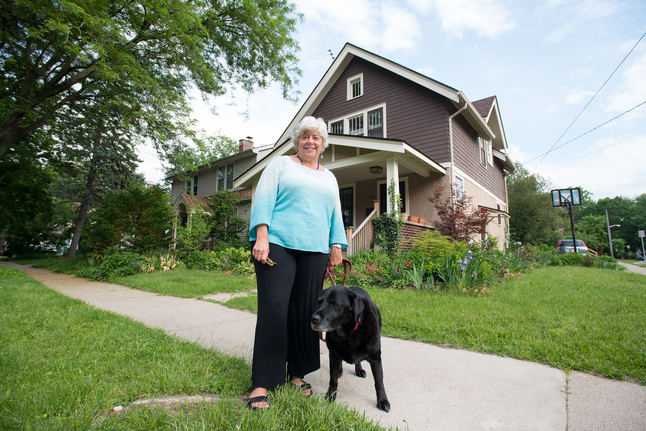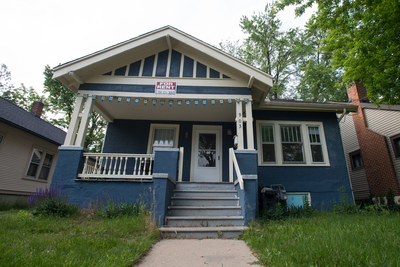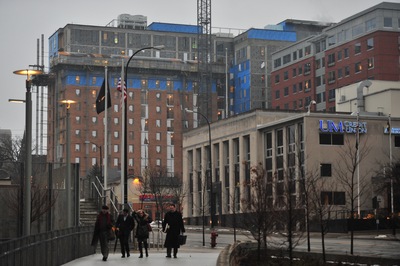Clik here to view.

Jane Deering has lived in her home on Dewey Avenue in the Lower Burns Park neighborhood since 1977. Over time, she's watched homes on the street be converted to student rentals.
Courtney Sacco | AnnArbor.com
When Jane Deering purchased her home on Ann Arbor’s Dewey Avenue in 1977, she loved the mix of families, elderly residents and University of Michigan students living in the neighborhood.
“It was a great family street with maybe a few students. When my kids were young, there were actually other kids for them to play with and that was lovely,” she explained.
Thirty-six years later, Deering said the street has changed.
Many of the single-family homes on Dewey Avenue — in between State and Packard streets and just blocks from U-M’s athletic campus — have been converted to student rental properties. “For Rent” signs are posted on many of the homes, advertising fall move-in dates and rental rate specials.
But with thousands of new student apartment units coming online closer to campus, many landlords, residents and city leaders are asking the same question: How will the new downtown apartment buildings affect the residential neighborhoods surrounding campus?
A smart investment
For decades, investors saw opportunity in neighborhoods like Lower Burns Park, the Old West Side and near East Ann Street by U-M’s medical campus. As the university’s enrollment grew and the student population spread out around town, investors purchased single-family homes to convert to student rentals.
“In the 70s, 80s, 90s and even 2000s, nearly every house that came on the market in those neighborhoods they were almost immediately snapped up by investors who would divide rooms, maybe put in another bathroom, and then fill them up with students,” explained Ann Arbor Mayor John Hieftje.
Clik here to view.

A home on Dewey that has been converted to a student rental property.
Courtney Sacco | AnnArbor.com
“(Lower Burns Park) was a nice entry point, so I think a lot of new investors or smaller investors saw that area was turning heavily to rental,” Starman said. “Most of the houses we own or manage, I believe, were bought from owner occupants.”
Neighborhoods shifted, and in some areas closer to campus, it led to an exodus of families that didn’t want to live in homes surrounded by students.
Leasing pressure?
The downtown and near-campus apartment market has welcomed more than 1,500 new beds in the past several years. Approved and under-construction projects such as The Varsity, 413 E. Huron, the Pizza House development and Ann Arbor City Apartments will result in an additional 1,300 beds in the coming years. Meanwhile, the university has plans to build a graduate student dormitory on South Division Street.
Clik here to view.

The 413 E. Huron development team pictured in Ann Arbor with the Varsity high-rise under-construction behind them.
Ryan J. Stanton | AnnArbor.com
Despite the new developments, Starman said leasing has been stronger than ever at Madison Property Company’s rental properties on the fringes of campus.
“So far, there’s no evidence that the students aren’t still abundantly renting in those neighborhoods,” he said.
He said rental rates also increased about 5 percent to 8 percent this year.
Holland Management owner Gretchen Sleamon, who also owns and manages student rental properties, said her houses on Granger and Dewey are leasing earlier and at higher rates than previous years.
Sleamon said a number of factors — such as U-M’s dormitory renovations putting more pressure on the rental market, and the high premiums to live in the newer high-rise buildings — could be drawing students to live on the outskirts of campus.
“The clientele going to the high-rises are not the same people going to five-, six-, and eight-bedroom houses,” she explained. “Their parents can afford to pay $1,000 per bedroom, whereas the kids who rent on Dewey or Granger are more like people who can afford $500 per bedroom.”
Since the neighborhood between State and Packard streets also is close to U-M’s athletic campus, Sleamon and Starman said the neighborhood has always been a big draw for student athletes. They also rent their properties to a lot of graduate students. Starman said he’s waiting to see if that changes with the new units coming online.
“The Ann Arbor student rental market has been so resistant for so long, it’s by far the biggest change we’ve seen with high-rises coming up,” he said.
“I would think, ultimately, there will have to be some contraction (where students move closer to campus), but there’s always going to be a large group of students that really like the house rental kind of environment,” he continued.
Return of owner-occupied homes
Today, Deering’s home on Dewey Avenue is surrounded by student rentals, and several times each week, she asks neighbors to keep noise levels down or has to call the police to break up parties. She’s also had her car vandalized twice and she sees signs of neglect or disrepair on some of the homes on the street.
Although she’s considered moving several times, Deering feels attached to the home where she raised her kids and spent 36 years of her life. She’s hopeful the street could eventually convert back to single-family, owner-occupied homes as more development occurs downtown and near campus.
“People are always encouraging me to leave Dewey, but I don’t want to leave,” she said. “I hope that my neighborhood can shift back to more families. I loved this neighborhood and I love this house, and I don’t want to be forced out by drunk students.”
Hieftje said the Clean Communities Program he started in 2002, which helps to combat trash concerns, was a huge help for those neighborhoods. He said the city used to receive a lot of complaints from homeowners who were struggling to make family life mesh with their student neighbors.
“We had neighborhoods coming to us asking for zoning changes,” he said.
In 2008, Ann Arbor City Council voted to change the zoning of Golden Avenue in Lower Burns Park from multiple-family to single-family housing. Pre-existing rental units on the street were grandfathered in, but the rezoning was passed so that more multi-family dwellings weren’t developed.
Still, Hieftje said it’s difficult to determine who lives in a single-family home, since the zoning allows for up to four unrelated adults.
“It’s very difficult to regulate,” he said. “So one of the hopes, as the city looked at the possibility of more residential development downtown, is we would take the pressure off these neighborhoods, and I’ve seen evidence of that.”
The city also appointed the R4C/R2A Zoning District Study Advisory Committee in 2009 to examine the multiple-family dwelling district that surrounds downtown, but no changes have come about yet. Ann Arbor City Council is expected to consider a set of recommendations about the zoning districts in the coming months.
Alex Milshteyn, an Ann Arbor Realtor with Howard Hanna, said he’s starting to see homes being converted from student rental properties back to single-family homes in neighborhoods surrounding campus. That’s partly fueled by the low inventory of homes for sale, he said.
Milshteyn recently had rental property listed for sale on Granger Avenue, and he received three offers on the house from single-family dwellers. He was the project manager for converting the house back to a single-family home. Although that took a $10,000 investment, Milshteyn said he’s seeing evidence that buyers are willing to pay to convert a property back to single-family.
“For the first time, when someone is looking for a single-family home, I started looking at rental properties to see what’s out there,” he said.
“The reality is, I think (the student rental market) is oversaturated close to campus,” he said. “I think we have too much. So I think, ultimately, it’s going to play out that, especially in Lower Burns Park and parts of the Old West Side, those homes are going to become more single-family.”
Lizzy Alfs is a business reporter for AnnArbor.com. Reach her at 734-623-2584 or email her at lizzyalfs@annarbor.com. Follow her on Twitter at http://twitter.com/lizzyalfs.